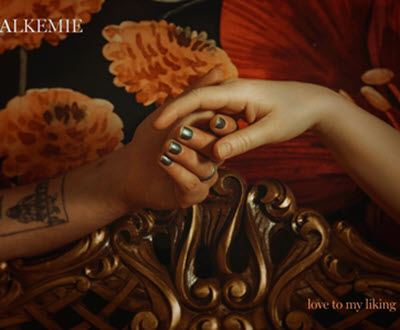by Aaron Keebaugh
Published April 28, 2024
Love To My Liking, 13th-century Trouvère Songs, Motets, and Dances. Alkemie. Bright Shiny Things BSTC-0201

“In all the world, there is no heart for me like yours,” Maya Angelou wrote. Her words not only express the elation of finally finding that special love, they hint at the pain of that bond being interrupted by events beyond one’s control.
Medieval writers were no less fixated on the wayward emotions of having loved and lost. But they could offer only fleeting solace should the experience inevitably tip towards the latter. Pain, some trouvère poets wrote, at least meant that you attempted to play the game. And the bittersweet feelings that sting the heart along the way — part of the human experience — connect us in common grief.

These are the ideas that the Brooklyn-based ensemble Alkemie explores in their latest album, Love to My Liking. Played and sung with verve, these evocative settings of 13th-century Northern French trouvère songs, motets, and dances serve as a reminder that love, then as now, can simply hurt.
Alkemie has delved into this timeless subject more than once in recent recordings. In January, the ensemble released an album with Freelance Nun called A Fine Companion, which sets troubadour texts to the sounds of shoegaze, dream-pop, and psychedelic rock. Given the lack of instrumentation and performance directions in the manuscripts for such material, their approach worked in spirit if not in strict performance practice. Let’s call the effort acid-HIP.
But Love to My Liking finds the ensemble returning to tradition. Drawing as much on contemporary folk and Celtic styles as Medieval historical performance practice, the tracks frequently teem with a rustic, down-home swagger. Various period percussion supports the ensemble of strings and winds with a firm and zesty beat.
If it dips slightly into extravagance, the result nonetheless fits the tone of this repertoire. After all, this music expresses celebratory zeal as well as poetic musing. Vibrant rhythms imbue “E, bone amourette/La rotta della Manfredina,” songs about the sheer joys of being in love, with infectious joie de vivre. Tracy Cowart, serving dual roles as singer and harpist, offsets it all with a sense of yearning.
Driving rhythms also underscore the rather square melody of “La joliveté/Douce amiete” as the singers tell of finding love after a prolonged search. The musicians render “L’autrier chevauchoie delez Paris” with a strong backbeat, which takes on greater vitality to convey the innermost tensions of loving someone who remains aloof.
“Li louseignolz que j’ai chanter” relays the varied tortures of loving to the point of personal destruction. Yet Sian Ricketts’ singing beams with a lyrical warmth, as if to relish the sweet pangs of loss. The lines of the multi-textural motet “Li maus amourous/Dieus, por quoi,” by contrast, generate a slow-burning stasis to underscore frustrations of loving another who does not return the sentiment.
The dance tunes balance these complicated emotions with restive exuberance. “La tierche estampie” whirls about seductively. So does “La septime estampie real,” where lifts at the ends of phrases enhance the toe-tapping groove. That combination of raw power and festive lilt also make a “La seconde estampie royal” into a quintessential, 13th-century def jam.
But it’s not all fun and games. “Bele doette as fenestres se siet” tells of a woman who loses her lover in a joust. Chant-like phrases unfold in wide leaps and arching shapes, conveying as much conviction as sadness. The text’s protagonist vows to become a nun, teaching all who come to her convent the full pleasures and heartbreak that come through love. Alkemie uses various string and wind combinations to craft a moving narrative. Through it all, the singers supply wistful refinement.
“Por mon cuer a joie atraire” also channels pent-up angst and ensuing sorrow. Subtle tosses of the voice suggest that even through such emotional turmoil, all might not be lost. Percussive rhythms then slowly build to a frenzy. Even amid the deepest blues, these performances seem to say that there is always a bright side. All one has to do is dance.
Aaron Keebaugh has written for Corymbus, The Musical Times, The Classical Review, and The Arts Fuse, for which he serves as a regular Boston critic. He teaches courses in music and history at North Shore Community College in Danvers, Mass. For EMA, he recently reviewed ‘All About That Bass: Continuo on Top.’




